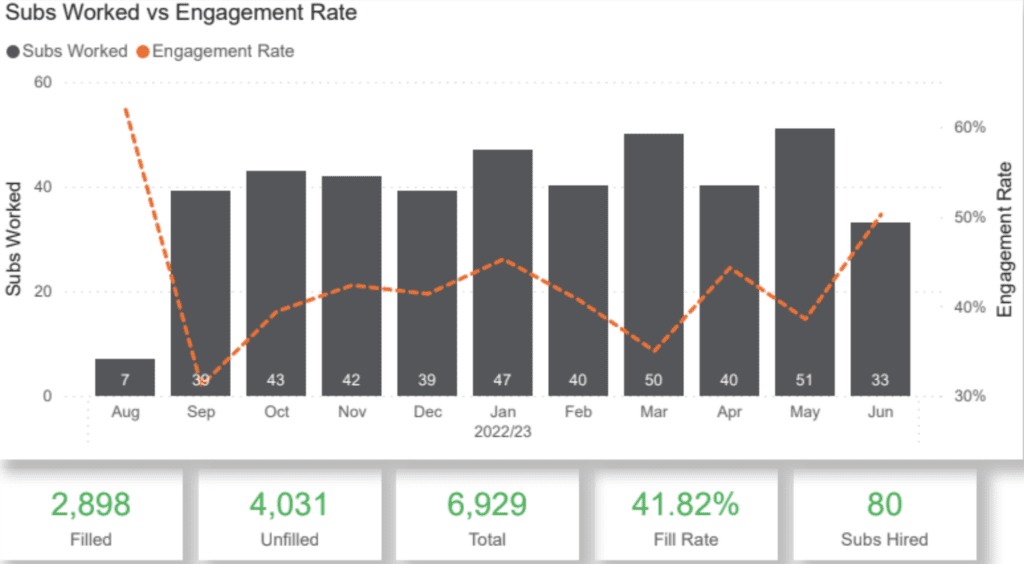A human resources director for the largest school district in Sussex County shocked a House Education Committee hearing in April when she told them about 300 of its 1,000 educators are off on any given school day.
About 800 of those educators are teachers, and their absenteeism rains down problems for the district, said Celeste Bunting, director of human resources at Indian River School District.
They may be off because they are sick themselves, they need to care for a sick child or spouse, they have a doctor’s appointment, or other reasons including a vacation day.
But the district must then scramble for substitute teachers or find another way to take care of their classes.
“We do have paraprofessionals who aren’t certified teachers who can fill in,” Bunting told the committee. “We may have in a seven-period day, seven different teachers who are willing to give up their planning period to fill in during that time. Or, we combine classes, and sometimes kids have to go into the gym to have a larger space.”
Indian River is not the only district dealing with that issue, but not all districts are.
Colonial School District in New Castle County and Milford School District in Sussex County have the same problem, but Caesar Rodney School District and Capital School District say it’s not a problem for them.
No one disputes that teachers and other educators have a right to take days off, and everyone interviewed for this story points to the national teacher shortage and problems finding substitutes as exacerbating classroom difficulties.
Delaware teachers have 10 sick days each year and three personal days, which are included in the 10. Teachers must get approval from school administrators for personal days.
Shelley Meadowcroft, director of public relations and communications for the Delaware State Education Association, the state’s teacher union, objects to descriptions of the problem as “teacher absenteeism.”
“Honestly it is a slap in the face to the profession to start calling it absenteeism when they’re using days that they’re actually given,” she said. “It kind of looks like a war on teachers at this point, where they’re damned if they do and they’re damned if they don’t at this point when using days that they’re given is taken in the negative connotation.”
Teachers are not abusing their benefits, she said, and the DSEA is in full support of teachers being able to use the days they do have.
The focus on absenteeism came partly because teacher time off was the centerpiece of three bills in the 2023 General Assembly:
- Senate Bill 60 gives teachers and other school employees the same protection to be absent without a loss of pay as other state employees to appear under subpoena to testify in a matter, unless they are one of the parties in the case or if the trial is directly related to that employee’s work. It also allows them to be absent from work to report to serve on a jury. It was signed by Gov. John Carney April 26.
- Senate Bill 61 changes teacher sick leave to make two more of the 10 sick leave days usable as personal days, making half the annual sick days available as personal days, but an administrator can deny a request for operational reasons. It also allows a school employee to use the one day of leave provided for the funeral of a near relative on the day before or the day after the funeral. It was passed by the Delaware House and Senate.
- House Bill 65 provides state employees who suffer a miscarriage, stillbirth or other loss, a maximum of five days of paid bereavement leave. It was signed by the governor June 30.
Meadowcraft noted that DSEA supported the amendment to SB 61 that allows school administrators to reject personal day requests.
“But again, if somebody’s father dies and they have to fly to Texas to bury their dad, are you going to tell me that they have to stay in the classroom because two other teachers have the stomach bug and they can’t bury their father?” she said. “We’re not talking about people going to Disney World.”
The stresses caused by the COVID-19 pandemic continues to add to the pressure that teachers feel.
“Our teacher burnout is making them take that time off more often than they would have in the past,” said Sarah Hale, chief financial officer of Milford School District. So will the state’s new Family and Medical Leave rules and the addition of two more personal days.
Hale said districts can end up bearing the financial brunt of teachers being absent.
“If a teacher is out and it’s not for one of the reimbursable reasons, like paid parental leave where we get the state share back, then yes, we have a cost,” she said.
That includes paying for a substitute teacher.
READ: Milford votes to decrease taxes for next year
Milford pays substitutes directly, rather than contracting with a substitute-providing company such as Kelly Services.
Milford also has hedged its bets by hiring its own long-term substitutes, with two in every school each morning ready for an assignment.
“They are just coming in every day and waiting for an assignment because we know there’s going to be absences and we want to make sure we have coverage readily available,” Hale said.
In the 2022-23 school year, Hale said Milford allocated $657,355 for substitute costs. Of that, $101,817 came from pandemic relief funds.
In the April 5 House Education Committee meeting, Bunting testified that Indian River can provide a substitute teacher or paraprofessional to handle a classroom about 75% of the time.
To help, Indian River has increased substitute pay to entice more people to become substitute teachers.
When classes are combined, Bunting said, students are not getting the same level of quality instruction as they would in a normal classroom.
Mondays and Fridays as well as days before holidays pose the most stress on operations, she said.
She recalled a Friday on which a school had 72 staff members in attendance and 35 absent. That forced administrative or school climate staff to fill in and forgo their work, she said.
Importance of communication
Kendall Massett, executive director of the Delaware Charter Schools Network, said effective communication between administration and teachers helps prevent problems when teachers call out.
Charter administrators may look at time-off trends and discuss them with teachers, Massett said.
If a school administrator sees an uptick in teachers being off on Mondays, Massett said, it’s important for admins to figure out the reason.
Sometimes, it’s as simple as teachers taking the day off for a doctor’s appointment because that was the day a doctor’s office gave them.
Once the staff realizes that lots of people doing that can create school-wide problems, it empowers the teachers to ask doctors for an appointment on a Wednesday or another day, she said.
Even with the teacher shortage, Massey said, effective strategies and communication between administrators and teachers can combat the negative effects of teachers being absent from work.
Open dialogue allows administrators to “spread absences” and make sure there aren’t too many classes to fill in one particular day.
“Certain things aren’t open on the weekend, and we’re all humans, we all have to take care of those human things that don’t happen after business hours, so how do we make that happen?” Massett said. “Well, we work together to find the days that are least impactful to the students in our schools.”
Here’s how teacher absenteeism is affecting a few of Delaware’s school districts:
Indian River
Bunting told the House Education Committee there has been an increase of teachers taking days off without pay, which indicates they are surpassing the number of days of leave offered with pay.
The group of educators she referred to also include paraprofessionals or counselors, who can fill in for an absent classroom teacher.
Bunting said the district uses A substitutes, B substitutes and C substitutes: A substitutes are certified or retired teachers; B substitutes hold bachelor’s degrees or above but not teaching diplomas; and C substitutes are high school graduates.
A school tries to source A substitutes first, and if they do not find anyone available, they look for an individual from the B or C level.
Bunting seems to expect the teacher shortage to continue.
“Right now we’re hiring for next year, so where I used to have a pool of 50 to 100 teachers, I might have five to 10 now,” she said to the April Kent County’s SOS Town Hall. “If it’s an elementary teacher, I might have zero applicants … So unfortunately, I don’t see it getting better immediately.”
Bunting said when she first started at Indian River in 2006, they would have hundreds of applications for an open position, so the district could really pick the cream of the crop. Now, far fewer eligible candidates are applying.
“We have fewer teachers per position, especially in the secondary areas like secondary math, secondary science, special education,” she said.
Some job postings are dropped altogether if there’s little or no interest in potential candidates, she said.
Since being a personnel director, Bunting said she’s attended about 250 career fairs.
“I’ve been at career fairs when you have 1,000 applicants, and in the last couple of years you may have 200 at most,” she said. “I was at a career fair in Baltimore where we had only two applicants, and we had 25 districts there, so there’s a teacher shortage.”
Districts citing teacher absenteeism as a problem is not helpful in trying to attract new teachers, Meadowcraft pointed out.
“It is a vicious cycle of we need more people to come do this great job and help kids, but when you come work for us, we’re going to complain when you take a sick leave,” she said. “I don’t understand how that conversation is beneficial to the retaining and the retention and attraction of people to the profession.”
Colonial breakdown
Colonial School District in New Castle County had 2,254 teacher absences from March 7 to June 7, according to Jennifer Alexander, the district’s director of talent development.
It’s 300 fewer than the same period in 2022, she said.
“But it’s still a problem,” Alexander said. “I think the biggest issue is not only that we have the absences, but we struggle to fill those absences with substitutes.”
From March 7 to June 7, 1,159 of the 2,254 absences were unfilled, she said, meaning 51.4% of classes didn’t have a replacement when the teacher called out.
“School administrators have become very creative with providing coverage for those classrooms,” Alexander said. “Teachers who are present in school often have to be very flexible in their schedules and allow additional students into their class, or maybe they have to cover a class during their planning period.”
A class cannot be uncovered so someone has to take on that responsibility, she pointed out.
Here’s a look at Colonial’s teacher absences and fill rates for the 2022-2023 school year:
As shown on the graphs, there are ebbs and flows to how many teachers are out throughout the year, with October, September and March being the three months with the highest number of absences.
Over the course of last year, 41.82% of classrooms were filled when a teacher was absent on a given day.
In total, there were 6,929 teacher absences during the last school year in Colonial.
“Any given day, we can have anywhere between 30 to 60 teacher absences” among the 650 teachers, Alexander said.
“I do believe, even when I was a building principal, a teacher would take a sick day maybe as opposed to a personal day, if they just needed a quick day off,” Alexander said, “because personal days are supposed to be submitted in advance.”
Alexander doesn’t think there’s substantial data to conclude that more teachers call out around the holidays or the day before a break.
Caesar Rodney
Caesar Rodney School District in Kent County employs about 710 teachers a year.
Administrators in Kent County’s Capital School District have said teacher absenteeism has not been an issue.
The district needed 827 substitute teachers in January, 771 subs in February, 1,065 in March, 560 in April, 884 in May and 180 in June.
“If a teacher is on paid parental leave, they would account for one of those absences every day for the full 12-week period,” said Mike Williams, district community relations specialist.
Not every school is impacted negatively by teacher absences, though.
“Schools are often able to rearrange things to avoid needing a sub,” Williams said.
Milford
Hale notes that when teachers are on paid parental leave, the school is reimbursed for substitutes, “but this does not apply to any other employee group that we must support through that mandate.”
Milford pays A substitutes $124 a day ($16.53 hourly), B substitutes $99 a day ($13.20 hourly) and C substitutes $79 a day ($10.53 hourly).
The finances are just one element to consider when evaluating whether teacher absenteeism has caused challenges.
“We’re pulling and working around teacher coverage within the buildings and we’re working within their contract negotiations to try to make sure it doesn’t put a strain on not only our substitute pool but our teachers who are left there when there are no subs available and kids are still sitting in classrooms,” she said, “so I would say that the issue expands far beyond any financial impact.”


Raised in Doylestown, Pennsylvania, Jarek earned a B.A. in journalism and a B.A. in political science from Temple University in 2021. After running CNN’s Michael Smerconish’s YouTube channel, Jarek became a reporter for the Bucks County Herald before joining Delaware LIVE News.
Jarek can be reached by email at [email protected] or by phone at (215) 450-9982. Follow him on Twitter @jarekrutz
Share this Post





